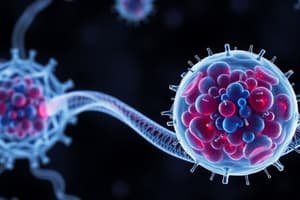Podcast
Questions and Answers
What is the primary role of catabolism in metabolism?
What is the primary role of catabolism in metabolism?
- Biosynthesis of molecules
- Cell growth and development
- Transport of nutrients
- Energy generation (correct)
In redox reactions, what does the term 'electron donor' refer to?
In redox reactions, what does the term 'electron donor' refer to?
- The substance that gains electrons
- The molecule that is oxidized
- The final product of the reaction
- The substance that loses electrons (correct)
Which of the following shows the correct oxidation and reduction processes in the overall reaction involving H2 and O2?
Which of the following shows the correct oxidation and reduction processes in the overall reaction involving H2 and O2?
- Oxidation: O2 → O-, Reduction: H2 + e- → H+
- Oxidation: H2 → H2O, Reduction: O2 + 2e- → O-
- Oxidation: O- → O2 + 2e-, Reduction: H2 → H2O
- Oxidation: H2 → 2H+ + 2e-, Reduction: ½ O2 + 2H+ + 2e- → H2O (correct)
What is essential for both energy generation and biosynthesis in cellular metabolism?
What is essential for both energy generation and biosynthesis in cellular metabolism?
Which classification describes organisms that obtain energy from organic compounds and carbon from CO2?
Which classification describes organisms that obtain energy from organic compounds and carbon from CO2?
In balancing redox reactions, which element is typically balanced last?
In balancing redox reactions, which element is typically balanced last?
What is the role of proton motive force in cells?
What is the role of proton motive force in cells?
What is the oxidizing agent in the oxidation of iron (II) to iron (III) with molecular oxygen?
What is the oxidizing agent in the oxidation of iron (II) to iron (III) with molecular oxygen?
What is the primary method of ATP generation during substrate level phosphorylation?
What is the primary method of ATP generation during substrate level phosphorylation?
Which reaction represents the overall cellular respiration equation?
Which reaction represents the overall cellular respiration equation?
What is the role of electron donors in redox reactions?
What is the role of electron donors in redox reactions?
In redox reactions, what does a more positive reduction potential indicate?
In redox reactions, what does a more positive reduction potential indicate?
How is energy released when electrons move down the electrochemical gradient?
How is energy released when electrons move down the electrochemical gradient?
Which compound is typically used as an electron acceptor in aerobic respiration?
Which compound is typically used as an electron acceptor in aerobic respiration?
What is a common challenge faced during fermentation processes?
What is a common challenge faced during fermentation processes?
What does the ΔG' represent in the context of redox reactions?
What does the ΔG' represent in the context of redox reactions?
What defines substrate level phosphorylation?
What defines substrate level phosphorylation?
Which of the following correctly describes the oxidation state of carbon in glucose?
Which of the following correctly describes the oxidation state of carbon in glucose?
What is the primary purpose of ATPase in cellular processes?
What is the primary purpose of ATPase in cellular processes?
Which of the following reactions represents a reduction process?
Which of the following reactions represents a reduction process?
How do microbes generate ATP when a H+ gradient is not feasible?
How do microbes generate ATP when a H+ gradient is not feasible?
What is the electron donor during anaerobic respiration when nitrate is the electron acceptor?
What is the electron donor during anaerobic respiration when nitrate is the electron acceptor?
Which process generates the highest amount of energy when using O2 as the electron acceptor?
Which process generates the highest amount of energy when using O2 as the electron acceptor?
What type of photosynthesis involves e- derived from H2S, Fe2+, or organic acids?
What type of photosynthesis involves e- derived from H2S, Fe2+, or organic acids?
Which enzyme is involved in converting hydrogen peroxide into water and oxygen?
Which enzyme is involved in converting hydrogen peroxide into water and oxygen?
In what way does the light affect chlorophyll during photosynthesis?
In what way does the light affect chlorophyll during photosynthesis?
What type of gradient is essential for the function of ATPase?
What type of gradient is essential for the function of ATPase?
Which of the following is NOT a characteristic of scalar reactions?
Which of the following is NOT a characteristic of scalar reactions?
Flashcards are hidden until you start studying
Study Notes
Metabolism
- Metabolism is the sum of all chemical processes within a living system.
- Catabolism breaks down molecules and releases energy.
- Anabolism builds up molecules and requires energy.
Cellular Requirements for Growth
- Cells require major and minor elements (like carbon, nitrogen, sulfur), water, energy from redox reactions, and reducing equivalents (e.g., NADH, NADPH) for growth.
- Approximately half of E. coli's genes are involved in metabolism.
Energy and Carbon Source Classification
- Microbes are classified based on their energy and carbon source.
- Chemo - energy from chemical compounds
- Photo - energy from light
- Organo - carbon from organic compounds
- Litho - carbon from inorganic compounds
- Hetero - carbon from organic compounds
- Auto - carbon from inorganic compounds
Life is Redox
- Free energy change (ΔG) determines the spontaneity of reactions:
- ΔG < 0: exergonic, releases energy
- ΔG > 0: endergonic, requires energy
- Standard conditions are denoted by a superscript 𐩑 and prime (') indicates pH = 7.
Redox Reactions
- Oxidation: loss of electrons (electron donor)
- Reduction: gain of electrons (electron acceptor)
- Balancing redox reactions:
- Balance carbon to carbon dioxide.
- Balance other elements.
- Use water to balance oxygen.
- Use hydrogen ions (H+) to balance hydrogen.
- Use electrons (e-) to balance charges.
Redox Potential
- Reduction potential: tendency of a compound to become oxidized or reduced, measured in volts (V).
- The more positive the reduction potential (E𐩑’), the better the compound accepts electrons.
Proton Motive Force/Electron Transport
- Electron transport chains generate a proton gradient (proton motive force).
- The greater the difference in redox potential between the electron acceptor and donor, the greater the energy released.
- ΔE’ = E𐩑’ acceptor - E𐩑’ donor
- ΔG𐩑’ = -nFΔE𐩑’
- n: number of electrons transferred
- F: Faraday Constant
ATP Generation
- ATP is the primary energy currency of cells.
- Two main mechanisms for ATP generation:
- Substrate-level phosphorylation (SLP): direct transfer of a phosphate group from a substrate to ADP.
- Transmembrane ion gradient: movement of ions across a membrane, often coupled to electron transport.
Fermentation
- ATP is produced by SLP.
- The substrate serves as both electron donor and acceptor, resulting in no net change in oxidation state.
- Fermentation relies on organic molecules as electron acceptors, unlike respiration, which uses inorganic acceptors like oxygen.
- Fermentation products vary depending on the starting substrate and the microbial organism.
Substrate-Level Phosphorylation
- A phosphorylated substrate is oxidized, releasing energy to form a high-energy phosphate bond.
- This energy is then transferred to ADP to produce ATP.
- All steps can occur in one reaction.
ATP Synthesis by ATPase
- ATPase is a protein complex that uses ion gradients to synthesize ATP.
- F0 subunit: hydrophobic, spans the membrane.
- F1 subunit: hydrophilic, located on the interior surface of the membrane, catalyzes ATP synthesis.
- 3-4 protons are transported per ATP molecule.
- ATPase functions are reversible.
Transmembrane Ion Gradients
- Ion gradients are generated via the proton motive force, which is used by ATPase and other processes.
- In environments where proton gradients are not feasible (high pH), microbes can use sodium (Na+) gradients.
- Importance of ion gradients:
- ATP generation
- Flagella rotation
- Ion-coupled transport
- Maintaining turgor pressure
- Maintaining pH
- NAD+ → NADH regeneration via reverse electron flow
Generating Ion Gradients via Respiration
- Electron transport across the cytoplasmic membrane generates an electrochemical gradient, driving proton export.
- Electron carriers can be specific for electrons or for both electrons and hydrogen ions (reducing equivalents).
- Oxygen as an electron acceptor yields the highest energy output but produces toxic byproducts like hydrogen peroxide and superoxide radicals.
Microbial Fuel Cells
- Electrodes act directly as electron acceptors, bypassing electron transport chain steps.
Generating Ion Gradients via Photosynthesis
- Occurs in a limited number of bacterial lineages (e.g., Cyanobacteria).
- Light transfers energy to chlorophyll molecules, making them strong electron donors.
- Chlorophyll absorbs light energy, enabling a flow of electrons down an electrochemical gradient.
- Chlorophyll and associated proteins and pigments form the reaction center, where electron changes occur.
- Antenna pigments collect light energy to funnel to the reaction center.
Types of Photosynthesis
- Cyclic: electrons flow from activated chlorophyll and back to the chlorophyll, primarily generating ATP.
- Noncyclic:
- Anoxygenic: electrons come from H2S, Fe2+, or organic acids.
- Oxygenic: electrons come from water (electron donor), occurs only in cyanobacteria.
Generating Ion Gradients via Enzyme Pumps
- Specific pumps, like bacteriorhodopsin, directly transport ions across the membrane without relying on electron transport chains.
Generating Ion Gradients via Scalar Reactions
- Reactions involve the production of protons internally, contributing to the proton gradient without directly transporting ions.
- Example: oxalate decarboxylase (oxalate + H+ → formate + CO2).
- Scalar reactions are not directly coupled to electron transport or light energy.
Studying That Suits You
Use AI to generate personalized quizzes and flashcards to suit your learning preferences.




